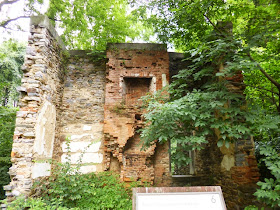The final spot we visited in
Cunningham Falls State Park was the ruins of the
Cotoctin Furnace. The furnace was in operation from 1776 to 1903. A variety of companies used the forge to make both pig iron and various implements from the iron ore mined from Cotoctin Mountain.
The valley was settled in the mid-1700s by English and German immigrants. Soon they were joined by Swiss and Scotch-Irish immigrants. The area started as farms but when the ore deposits were discovered, two brothers bought property and built the furnace. They were Thomas and James Johnson.
Thomas Johnson was later to become governor of Maryland after the American War for Independence. They had the furnace operating by 1776 and were supplying the Continental Army with ammunition.
The site was chosen for the nearness of resources needed. In addition to the iron ore veins, the area also had plentiful hardwoods for making charcoal, limestone, and water power from nearby Little Hunting Creek.
In 1856 a second furnace was built, named Isabella by the company. It is the stack that still stands today and the first thing seen by visitors to the forge.
 |
| Cotoctin Furnace--Isabella |
The furnace produced 3300 tons of pig iron a year and was in use during the American Civil War. The furnace is still impressive even today.
 |
| The main furnace (with J) |
A small path on the side of the furnace leads up a steep incline to the roof. At the top charcoal, iron ore, and limestone were added to the furnace. The combination was heated to 3000 degrees. The waste elements would mix with the limestone and float to the top, being poured off as slag. The remaining iron would be poured into forms, most of which were shaped somewhat like a sow feeding her suckling pigs. Hence the name "pig iron." During the Civil War, the iron was sent to nearby foundries to make supplies for the war effort.
 |
| Furnace roof |
 |
| L and Mommy down below |
Up by the roof is a small trail that leads off into the woods where more of the history of the furnace and the town can be seen.
 |
| Catoctin Furnace Trail sign |
Right next to the furnace is the Ironmaster's Manor House, which is now in ruins. The wealth of the ironmaster can be seen from the many fireplaces and the large layout of the house.
 |
| Ruins of the house |
 |
| Main wall with double-decker fireplace |
 |
| Entrance door? |
Nearby is the remains of a dam and raceway that diverted water from Little Hunting Creek. The sign for the dam and raceway was there but nothing was visible in the August overgrowth.
 |
| Unvisible dam |
Further down the trail I discovered the Bowstring Arch Bridge. With the overgrowth and the path crossing over the bridge, I was unable to get a good photo of the bridge itself.
 |
| Bowstring Arch Bridge |
 |
| View up Little Hunting Creek |
 |
| View down Little Hunting Creek |
Across the bridge I discovered the slag heaps where the dross from the refining process was dumped. Again, the overgrowth was substantial and I couldn't see anything from the path that looked slag-like.
 |
| Stairway to slag heap, now all greenery |
Further down the trail I discovered a bridge across Route 15. I was getting a little too far from the family who were waiting back at the furnace so I turned back. At the parking area I found Granny and J playing catch!
 |
| J catches! |
The moral of this post is that if you want to visit the Cotoctin Furnace, best to do it when the leaves are down and the ruins are more visible! Otherwise it was a fine place to learn a little about history and industry.
 |
| Cool map of the area (click to enlarge) |















No comments:
Post a Comment